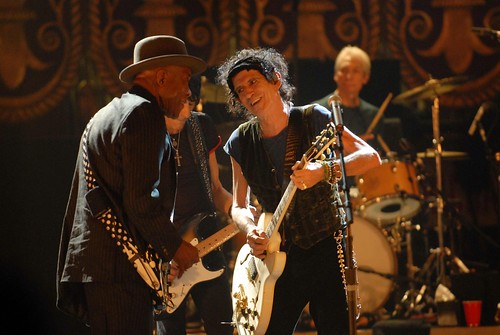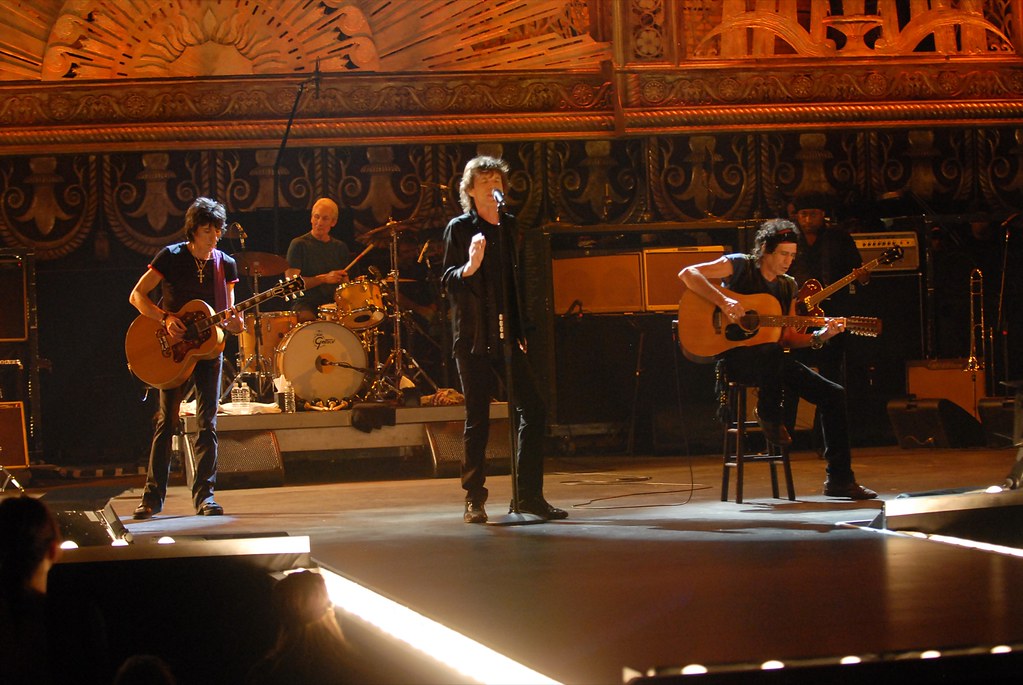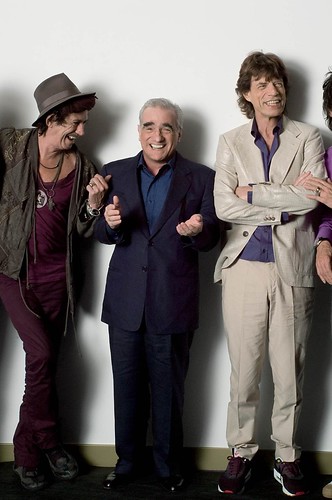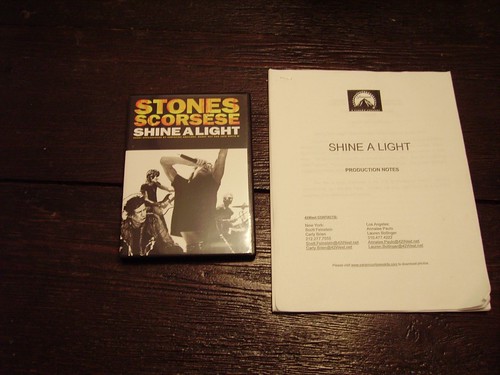By Noë Gold

Finally, it can be posted under my name. You see, when you go here, for some reason it says the article is by Andy Hunsaker, and then below that it says it's by me. Who the fuck is Andy Hunsaker anyway?
Anyway, the Flickr post above gives you a tease, an excerpt of Keef's wit regarding his adulation of Mr. Guy. ...
Noe Gold: Speaking of that, after your number with Buddy Guy, Buddy carries your guitar off the stage. I don’t know how he did it but he got Buddy Guy to be your guitar carrier at the end of the shot.
Keith Richards: What happens there is that I give Buddy Guy my guitar. And you haven’t heard the overdub because I hand Buddy Guy my guitar and say, “It’s yours.” That’s the point there. (laughs) I had to do the voiceovers in Barcelona for Marty because we didn’t quite pick it up on the stage. I handed Buddy my Gibson guitar and said, “Hey Buddy, this is yours.” I’m happy to clear that one up. No way would I ever ask Buddy Guy to carry my guitar, man! KM-079 Photo Credit: Kevin Mazur (Left to right) Buddy Guy, Keith Richards and Charlie Watts performing onstage at the Beacon Theater during the Rolling Stones concert film “Shine A Light.”
Paramount Classics in Association with Concert Productions International and Shangri-La Entertainment Presents A Martin Scorsese Picture “Shine a Light” starring Mick Jagger, Keith Richards, Charlie Watts and Ronnie Wood. The film is directed by Martin Scorsese. The producers are Victoria Pearman, Michael Cohl, Zane Weiner and Steve Bing. The executive producers are Mick Jagger, Keith Richards, Charlie Watts and Ronnie Wood. This film has been rated PG-13 for brief strong language, drug references and smoking. © 2008 by WPC Piecemeal, Inc. All Rights Reserved.
... So here's another one for the ages: I'm going to pste the entire double interview with the Glimmers right here:
Fancast Interview: Mick Jagger & Keith Richards Shine A Light On Their Latest Documentary
By Noë Gold Fancast.com
Beginning in August 2005, the Rolling Stones spent two years the globe on their “Bigger Bang” tour, taking in more than $580 million. Director Martin Scorsese captured two nights on film [watch him direct] when the band stopped at New York’s intimate Beacon Theater. The shows featured different set lists and guests Buddy Guy, Jack White, and Christina Aguilera. The effort turned into the documentary Shine A Light, which critic Roger Ebert said “may the most intimate documentary ever made about a live rock ‘n’ roll concert.” Fancast contributor Noe Gold spoke to Mick Jagger and Keith Richards about the film, which the Stones’ seemingly ageless frontman originally envisioned focusing on their free concert on the beach in Rio. “It was going to be a big event, a million people on the beach, a huge audience, a big occasion,” said Jagger. “And then we started to think, if we’re going to do this, we might as well start with a really top-flight filmmaker, even if we don’t get one, it’s good to start at the top, you know? (laughs). And so then we started thinking about who could do this and so on. I was talking to Martin Scorsese about another film project, and we said, well let’s ask Marty, because we know he’s actually not shooting at this period. So we asked Marty and he said he’d love to shoot the Rolling Stones concert. That’s the sort of short version.
Shine A Light [watch the trailer]:
NG: And then you got to work? Jagger: Then we had a meeting with Marty in where we had a sit-down in New York where I chatted with him – it was this stunning meeting in my hotel room. There was a storm, the wind was blowing, there was a window that wouldn’t close and the curtains were blowing and the chandeliers were wobbling and everything and we’re all sort of laughing about it. So we talked about shooting in 3-D, and shooting in Imax, whatever. Because it was such a big event. I was focused on this big event because I thought it was different.
Marty seemed very excited by this idea, but then on the next meeting, he came back and said, he’d been thinking about it and what he really wanted to do was shoot something more intimate. So we’d come around completely — I’d gone from a million people … and he’d gone to … something small. So I said, you know Marty, the other problem is, we don’t have any intimate places booked on the tour. We have lots of not-intimate places but we don’t have an intimate place. We have a fully booked tour schedule — you know, how are we going to do this? And he had to convince me – he said, this is my kind of forté, is to shoot these intimate things.

Keef Brings out the 12-string on the rare “As Tears Go By”
NG: You’re no stranger to working to working with auteur filmmakers. Jean-Luc Godard for one, Robert Frank … Richards: and “Hail, Hail Rock and Roll” – Taylor Hackford. To me, this one is on a par with that one. It’s different because it’s a Stones show but – a very superior rock and roll film. NG: What’s different about prepping for a big concert in a big arena from a small filmed theater show. Jagger: That’s just part of the bigger question. Because it’s a film to watch in a movie house or on a DVD. So it’s not just for a theater audience. It’s got its own aesthetic. You’re not going to do the same show that you do in a big place. The problem was, we didn’t have a theater show on this tour. In the previous tour we’d had a theater show. In other words we’d had a set list that was different for theater which featured different numbers, It was more intimate. These had to all be invented. And then, the other thing was it’s always nice in a film like this to have guest artists. So you had to think about them, what kind of numbers are they going to sing and what can they do. How’s that all going to dovetail into the rest of it. So it’s not just think of a set list per se. It’s think of a movie set list of the presentation.
NG: Keith, what did you want the movie-going audience to get that a live arena show audience might not get? Richards: Actually to me, what was really intriguing was getting Marty’s take on it, and his vision of it. I mean, I’ve been in a lot of Stones films, and I don’t often see them. To me, the really intriguing thing was that Martin Scorsese wanted to do something like that, and I thought, well, he must have something in mind that is like beyond the usual sort of video scan, the usual stuff. So I really wanted to find out what Marty wanted.

Marty and his twin auteurs
NG: How did you come up with the guest artist list for the show? Jagger: We’d always worked well with Buddy Guy. We’d played with Buddy Guy before and we always admired him, and he was always good to play with on stage. We thought that would be good with our connection with the blues. And we always liked playing with him. He’s an easy guy to work with and he always delivers well on stage. And then I thought that Jack White, I’ve always liked him. We played concerts with him before and I knew him a bit, and I knew that that would work quite well. I thought we’d do this slightly different so instead of it being a kind of really raunchy rock scene we’d take it in a slightly different direction. And Christina Aguilera, she’s a great singer and everything, so I knew she would put in a good performance and so that’s how it worked.
NG: Keith, you said that you could recite Martin Scorsese’s dialogue. Another great segué that he did was when you guys had Jack White up there in this three-way acoustic guitar jam. Mick was playing an acoustic and Jack was playing with a slide, and then he segues to you on a 12-string for “As Tears Go Bye” Richards: How many times have we all watched fingers going up and down fretboards? The thing that Marty did with it was he turned the observation into a Rembrandt. It shows the beauty of the guitars themselves. It wasn’t just who was playing them. It was the loving shots of the instruments themselves, which I found very, very, very nice.

Noë Gold wrote these.
NG: Speaking of that, after your number with Buddy Guy, Buddy carries your guitar off the stage. I don’t know how he did it but he got Buddy Guy to be your guitar carrier at the end of the shot. Richards: What happens there is that I give Buddy Guy my guitar. And you haven’t heard the overdub because I hand Buddy Guy my guitar and say, “It’s yours.” That’s the point there. (laughs) I had to do the voiceovers in Barcelona for Marty because we didn’t quite pick it up on the stage. I handed Buddy my Gibson guitar and said, “Hey Buddy, this is yours.” I’m happy to clear that one up. No way would I ever ask Buddy Guy to carry my guitar, man!
NG: Brilliant. So that brings me to my final question, a kind of auteur filmmaker question: How does the experience of going before Martin Scorsese’s cameras compare to being “documented” by such auteurs as Jean-Luc Godard, Robert Frank, The Maysles Brothers, Peter Whitehead, Hal Ashby? Jagger: Yeah, the comparison is kind of valid I think. But you know quite a lot of those people were actually doing documentaries, and this is mostly a concert movie. They’re all great filmmakers, the ones that you mention. I think that Marty is a wonderful filmmaker and I’ve known him for some time. And I think he really has a great passion for this. It’s not something he just … tosses off in a week so to speak as a bit of fun thing. He’s very involved, super-involved in the editing, getting it just right. They’re still working on it to the last minute. He’s fantastically devoted to detail, which is very important in this, and to the concept of it before rather than any kind of … you know he hated the idea of winging it, as you could see with the set list. But in all the post-production he is extremely careful, he wants to get everything right and get the maximum emotion out of it, get the all the relationships, work on all that as hard as he can. So I think that he’s a great guy to work with. And he’s very very cooperative. He’s not a person who dictates to you or takes the sort of high ground in knowledge or anything like that and listens to your points and either takes them or doesn’t take them. He’s very cooperative.
No comments:
Post a Comment